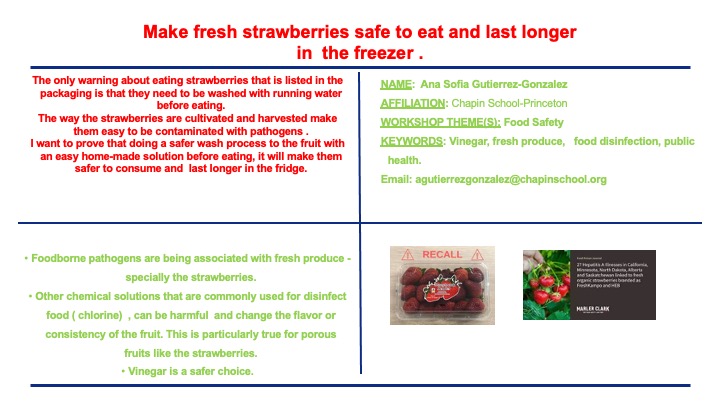The Effect of home-made disinfectant solutions on strawberries freshness.
Abstract:
With this experiment, the goal was to test different cleaning methods on strawberries to see which one could keep them fresh longer. It was proven strawberries that were washed in the vinegar solution had the highest point mean of 13.9, which meant that all of the strawberries in that group had signs of freshness than the other 2 groups. One of the strawberries from the water group had a fungus growing, which proved that water isn't the best option to wash fresh produce.The data was collected through freshness points, which measured the physical form of the strawberry such as signs of spoilage. At the end of data collection, the hypothesis was accepted! Using plain water to clean strawberries or fresh produce is not the best idea to get rid of pathogens. A vinegar solution is. I recommend to do this extra step to ensure a clean and delicious batch of strawberries!Bibliography/Citations:
1.- Amanda Scott. Safe Handling of fresh Strawberries. (2022) https://galveston.agrilife.org/files/2012/03/Safe-Handling-of-Fresh-Strawberries-Publ.-E-204.pdf
2.-Lafarga, Tomás, et al. “Strategies to Reduce Microbial Risk and Improve Quality of Fresh and Processed Strawberries: A Review.” Innovative Food Science and Emerging Technologies, vol. 52, Mar. 2019, pp. 197–212. https://doi.org/10.1016/j.ifset.2018.12.012.
3. Strawberries & More. University of Illinois Extension. https://web.extension.illinois.edu/strawberries/facts.cfm
4. Cortesia C, Vilchèze C, Bernut A, Contreras W, Gómez K, de Waard J, Jacobs WR Jr, Kremer L, Takiff H. Acetic Acid, the active component of vinegar, is an effective tuberculocidal disinfectant. mBio. 2014 Feb 25;5(2):e00013-14. doi: 10.1128/mBio.00013-14. PMID: 24570366; PMCID: PMC3940030.
5. Lynch Kara, MSU Extension Food Safety Educator. Safe Sanitizing & Disinfecting. E-3446.January 2021.msue.msu.edu/safefood
Additional Project Information
Research Plan:
Procedure:
Will be done in the Home Kitchen Counter
1. Get a pack of strawberries from the same brand
2. Select 45 stemmed strawberries about the same size, weight, color, and freshness
3. Using a kitchen scale, weigh your strawberries and record the weight on a sheet of paper
4. Preparation of the 1:1 water-vinegar solution.
4A:Open a new bottle of distilled white vinegar
4B:Using a clean and dry graduated cylinder, pour 500 ml of water. 4C:Carefully, add 500ml of vinegar to the water.
4D:Seal the cylinder and mix the liquids.
4E:Label the cylinder as “Vinegar solution.” Set aside.
5. Preparation of 1 liter of salt solution (10%: 10 grams of kitchen salt in 100ml of water)
5A: Weigh 100 g of kitchen salt on the kitchen scale
5B: Use another clean and dry graduated cylinder and measure 1,000 ml of water .
5C:In a 1,000 ml beaker, pour the salt and then add 200 ml of water. 5D:Mix with a clean spoon until there isn't any solid salt left. 5E:Transfer the solution from the beaker to the cylinder.
5F:Add more water to the cylinder to reach 1,000 ml.
5G:Seal the cylinder and mix.
5H:Set it aside and label it “Salt solution.”
6. Get 5 strawberries into each of the 9 aluminum trays
7. Label 3 trays with “Water”, 3 with “Vinegar”, and 3 with “Salt.”
8. Add 300 ml of tap water to the 3 “Water” trays and start a timer for 10 min.
9. Add 300 ml of the vinegar solution to each of the 3 “Vinegar” trays and start the second timer from 10 min.
10. Add 300ml of the salt solution to each of the 3 “Salt” trays and start a third timer for 10 min.
11. When the time is up, transfer the strawberries with tweezers to a tray of 300ml of clean water and rinse 3x carefully for 5 min. (Note: be sure the solution covers all the strawberries)
12. After rinsing, transfer the strawberries with tweezers to their own separate piece of gauze. Keep every group separate.
13. Pat gently to dry
14. Afterwards, transfer the strawberries into their own ziploc bag. There should be 15 bags in all. Name them “Water 1,2, or 3”, etc.
15. Put all the bags into the fridge for 5 days
16. After 5 days, remove all the bags from the fridge.
17. Realize the visual inspection of every strawberry on the bag, assigning the number of points accordingly the picture on figure #1.
18. Collect the data on a table.
19. After the data collection, discard the strawberries in the regular trash can. NOTE: The strawberries are not to be consumed after the experiment is stopped and analyzed.
Analysis
1. After five days in the fridge, take all the bags out and do a visual inspection, following the picture on figure 1.
2. Give each strawberry a point based on the visual description in each bag
3. Add all the points together and find the average for each group. (Water,salt,and vinegar)
4. Make a data table for each of the groups (water,vinegar,salt) describing each strawberry from each bag and make a bigger one for all of them together as shown on figure 2.
5. Make a bar graph comparing the averages between water,salt and vinegar.
Fig 1: Evaluation of the freshness of strawberries

